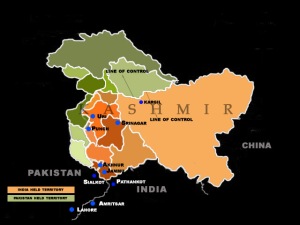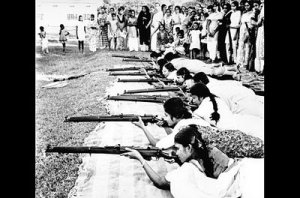Introduction
The Second Indo-Pakistani war was fought over the Indian province of Kashmir. This war, initiated by Pakistan after the defeat of India by the Sino-Indian War in 1962 did not start with a formal declaration of war. This was because Pakistan believed that India would be unwilling or do not have the power to defend against a swift military campaign in Kashmir. In addition, Pakistan was increasingly alert that India was attempting to establish rule within Kashmir. A common perception was that there was popular support for Pakistani rule within Kashmir disagreed with Indian rule.
Engagement
Around 26,000 to 33,000 Pakistani troops crossed the Line of Control on August 5th, 1965 dressed about Kashmir locals. They dispersed themselves into various areas of Kashmir. Indian forces were tipped off by legitimate Kashmiri locals and crossed the cease-fire line on August 15th of the same year. Initial battles were exclusive only to Kashmir, with substantial support of armored units and the air force from both sides. By early September, Pakistani forces launched an offensive against Ackhnur. This act of aggression escalated the war as Indian forces began attacking Pakistani targets, forcing Pakistani military units to disengage from Ackhnur. The largest engagement of both countries occurred in the Sialkot region, where 400 to 600 tanks were mobilized. However, this battle was indecisive.
United States Involvement
Pakistan was shocked at the United States’ reaction to the war. From the perspective that the war was Pakistan’s fault, the United States’ first refused Pakistani aid promised and established under the terms of the Agreement of Cooperation, but also declared its neutrality and cutting of its military exports to Pakistan. However, the firearms that were supplied to both nations by the United States’ were under the condition that they would not be used against each other. The original intent for the supply of weapons to both nations was to counter the Chinese influence in the area. This condition that was erected during the Kennedy and Johnson administrations was a reflection of the flaw American policy that would plague them for decades. Furthermore, the United States’ was disillusioned by the fact that both sides mobilized US supplied equipment. This war also brought other backlashes against the security agreement. The United States’ withdrew its military assistance advisory group on July 1967. As a firm response, Pakistan refused to renew the lease on the Peshawar military facility, which ended in 1969. United States-Pakistan relations grew substantially weaker as the US was more occupied with Vietnam and its boarder interest in South Asia was diminished.
As stated by the US Library of Congress’ Country Studies on Pakistan, “Each side held prisons and some territory belonging to the other. Losses were relatively heavy—on the Pakistani side, twenty aircraft, 200 tanks, and 3,800 troops. Pakistan’s army had been able to withstand Indian pressure, but a continuation of the fighting would only have led to further losses and ultimate defeat for Pakistan. Most Pakistanis, schooled in the belief of their own martial prowess, refused to accept the possibility of their country’s military defeat by ‘Hindu India’ and were, instead, quick to blame their failure to attain their military aims on what they considered to be the ineptitude of Ayub Khan and his government.”
Ceasefire
On September 22nd, 1965, the United Nations Security Council passed a resolution that forced an unconditional ceasefire for both sides. The Soviet Union delegation, led by Premier Alexey Kosygin, brokered a ceasefire deal in Tashkent (Uzbekistan) where Indian Prime Minster Lal Bahadur Shastri and Pakistani President Ayub Khan signed an agreement to withdraw military forces back to pre-august lines before February 25, 1966. The war remained inconclusive and there was no gain on both sides, however Pakistan suffered relatively more.
Kashmir: Pakistani occupied territories are in green hues, Indian territory in orange hues.
Pakistani housewives target practice, responding to a government call of arms.
Citations:
“Indo-Pakistani War of 1965.” ItsPakistan. N.p., n.d. Web. 06 June 2014.
“Late Night Cafe.” : The 14 Turning Points in Independent India. N.p., n.d. Web. 06 June 2014.
“Military.” Indo-Pakistan War of 1965. N.p., n.d. Web. 04 June 2014.
“Second Kashmir War – Pakistan, India and the Second Kashmir War (1965).”Middle East News and Issues from About.com. N.p., n.d. Web. 6 June 2014.

